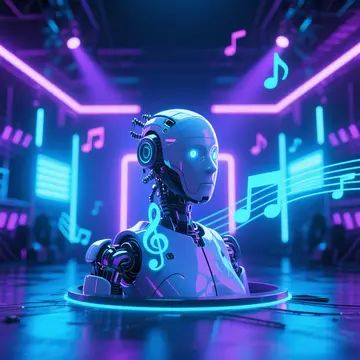Introduction: Bringing Digital Characters to Life with AI Voice and Animation
Creating a virtual idol, animated avatar, or digital character that truly captivates an audience involves more than just stunning visuals. The voice and animation must synchronize perfectly to convey emotion, personality, and authenticity.
In recent years, advances in AI voice generation and animation tools have revolutionized content creation. From Synthesizer V producing human-like singing voices to Unreal Engine or VTube Studio animating characters in real time, merging these technologies is now accessible to creators of all skill levels.
This article will guide you through the top workflow to combine AI voice and animation, explaining each step, essential tools, and tips for seamless integration to help your digital character shine.

Step 1: Generate or Record the AI Voice
The first step is to create the voice your digital avatar will use. Depending on your project, you can generate singing vocals, spoken dialogue, or both using AI.
Choose Your AI Voice Generator
Synthesizer V: Ideal for expressive singing with fine pitch and emotion control.
Suno.ai: Generate full songs and vocals from text prompts.
ElevenLabs: Excellent for realistic speech and narration.
Google Cloud Text-to-Speech: Supports multiple languages and emotional tones.
Custom Voice Cloning: Use open-source tools like Diff-SVC to clone specific voices.
Tips for Voice Creation
Export the voice track in high-quality WAV or FLAC format.
If producing singing vocals, ensure timing and pitch are finalized.
For dialogue, consider including breath sounds, pauses, and intonation for naturalness.
Step 2: Prepare the Animation Assets
Before animating, gather or create your digital character models and assets.
Options for Character Assets
3D Models: Use software like Blender, Unreal Engine, or Unity with rigged characters.
2D Avatars: Utilize tools like Live2D Cubism or VTube Studio for real-time 2D animation.
Prebuilt Avatars: Platforms like Ready Player Me or VRoid Studio offer customizable avatars.
Rigging and Facial Blendshapes
Ensure your character has a facial rig or blendshapes for mouth movements, blinking, and expressions that can be driven by audio or input data.
Step 3: Sync AI Voice to Animation (Lip-Sync and Expression)
Synchronizing the AI-generated voice with your character’s animation is the most crucial and challenging part.
Automated Lip-Sync Tools
Rhino Lip Sync (for Unreal Engine): Converts audio to visemes for facial animation.
Papagayo-NG: Free tool that maps phonemes to mouth shapes.
Adobe Character Animator: Auto lip-syncs based on audio input.
Voicemod + VTube Studio: Real-time lip-sync with AI voices for VTubers.
Manual Refinement
After automated sync, adjust keyframes manually to fix mismatches or add emotional expressions (smiles, frowns) to enhance realism.
Expression and Emotion Mapping
Some advanced tools support emotion recognition from voice input and can trigger corresponding facial expressions automatically.
Step 4: Animate Body Movements and Gestures
To bring life beyond lips, animate gestures, posture, and eye movements.
Tools and Techniques
Motion Capture (Mocap): Use devices like iPhone FaceID, Leap Motion, or dedicated mocap suits.
Keyframe Animation: Manually animate gestures in Blender or Unreal.
AI Motion Generation: Emerging AI tools can generate body movement from audio or text prompts (e.g., DeepMotion).
Step 5: Composite and Edit Video
Once the voice and animation sequences are synced and polished, composite them into a final video.
Editing Software
Adobe Premiere Pro or DaVinci Resolve for video editing and color grading.
After Effects for special effects or overlay graphics.
Export final video in high-definition formats (1080p or 4K) for streaming or publishing.
Step 6: Publish and Optimize for Platforms
Your final step is sharing the AI voice and animation combined content.
Platform-Specific Tips
YouTube: Use keyword-rich titles and tags like "AI voice avatar," "virtual singer," or "VTuber animation."
TikTok & Instagram Reels: Short clips with catchy AI vocals and dynamic animation can go viral.
Twitch: Use real-time AI voice and animation for live performances.
Optimize metadata for SEO and accessibility with captions or transcripts.
Bonus Tips for a Smooth Workflow
Batch Processing: Generate voice segments and animations in batches to save time.
Use Middleware: Middleware like Faceware or Live Link Face can streamline syncing facial animation with audio.
Test on Multiple Devices: Preview your animation on various screen sizes and platforms.
Backup Regularly: Save versions of your voice and animation files to avoid loss.
Conclusion: Mastering the Fusion of AI Voice and Animation
Combining AI voice generation with animation unlocks limitless creative potential—from virtual concerts to interactive VTubers. While the technology continues to advance rapidly, following a clear workflow helps maintain quality, authenticity, and audience engagement.
By carefully generating expressive AI vocals, preparing detailed animations, syncing lip movements precisely, and publishing strategically, creators can produce digital characters that truly feel alive.
Start experimenting today and watch your virtual idols take the stage like never before.
FAQs
Can I use AI-generated voices in real-time VTuber streams?
Yes, tools like Voicemod combined with VTube Studio support real-time AI voice processing and lip-sync.
Which software is best for lip-sync automation?
Adobe Character Animator is user-friendly; Rhino Lip Sync is powerful for 3D engines.
Do I need programming skills to combine AI voice and animation?
Basic workflows require no coding, but advanced setups (custom mocap or voice cloning) may need technical knowledge.
How to make AI voices sound more natural with animation?
Incorporate breathing sounds, vary pitch, and sync facial expressions to emotional cues in the voice.
Learn more about AI MUSIC
